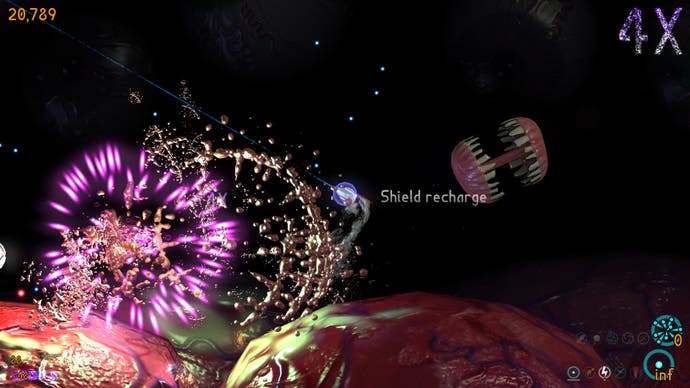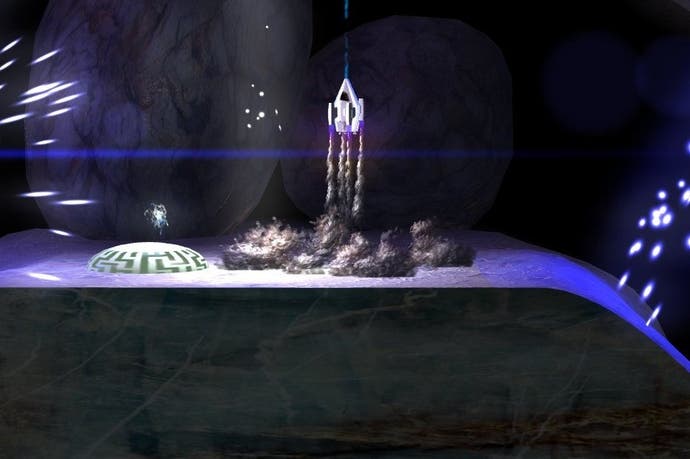Meet Retrobooster, a cave-flyer inspired by Lunar Lander
By a guy who used to go to work at NASA.
Before Terry Welsh quit his job working at NASA's Moffett Field in California, he used to ride his bike to work every day and leave it chained under the world's largest wind tunnel. "The coolest thing about working at a place like that is that everything's so big," Welsh explains. "Everything's gigantic. That wind tunnel has an 80 by 100 foot test section where they'd put planes. They can put full-sized aircraft in there, and the intake vent is about five times that area."
Welsh, who was a contractor attached to UC Santa Cruz, spent his days at Moffett Field building simulations. By night, he started putting his own game together - a cave flyer called Retrobooster. As exciting as it was to work near the world's largest wind tunnel, it ultimately wasn't as exciting as game development. Eventually Retrobooster took over and Welsh quit his job to devote all his time to it..
"The part that made it easier is that the programming is very similar," he says when asked about his change in career. "I was doing graphics programming on both ends. With games, though, it's more creative. I'd been at the NASA site about six years and while it was a good job, I'd been working on this game project for a while and the testers were really enjoying it. I figured that this was a good opportunity to find something new to do."

While Retrobooster doesn't have too much in common with the simulation work Welsh was doing at Moffett's Field, it has an awful lot in common with Lunar Lander, one of the earliest, and most famous simulation games ever made. Like Lunar Lander, a simple affair concerned with touching down safely on the moon, Retrobooster's a thrust-based game in which you're constantly trying to use physics to keep you alive as you navigate a 2D environment. Throw in some enemies and puzzles and it's unashamedly difficult - just like the kind of games to which Welsh has always been drawn.
"I probably played way too much Oids in high school," he tells me. "That's a great old cave flyer. I loved Oids but I always wanted one that was much harder and not all about picking up fuel dumps." Welsh thought he could offer the player other challenges, even if that meant making a game himself. "I just set out to build something I liked," he says. "It took years and years because it was a hobby project. It was being put together whenever I got home from work."
Retrobooster uses the Asteroids (and the Lunar Lander) control model: you hold down a button for thrust and then move your ship around to change the direction you're actually thrusting in. It feels like we've been buried alive under twin sticks for the last few years, so it's quite exciting to see thrust-based games making a small resurgence, both in Retrobooster and titles like Galak-Z: The Dimensional. Thrusting to move gives you a lot to think about as you pick a path through the environment, and that means the controls have to be extremely precise.
While Retrobooster is not the prettiest game you will ever see in your life, what sets it apart from other 2D arcade titles is the sheer responsiveness of it. I haven't played many games that give you such a vivid sense of power from just grasping the controller. Welsh's environments are chaotic and hazardous - aside from jutting walls to smash into, the place is loaded with enemies - and yet he has the good grace to give you exactly what you need to get through them. When I asked how he managed to give players such fidelity of control, he offers a surprising answer.

"It's actually pretty easy to get that," he says. "I think most other games take it away again. That's one of the things I wanted to change with this game. Games have gotten easier and easier over the last 30 years. They'll add in some drag so you lose your inertia, they'll make your thrusters not quite as powerful. It's easy to do and it's more mass-marketable I think, but there are still a lot of people out there who like hard games. I just left all the physics in there as raw as they can be and made the acceleration in there nice and quick. So yeah, it's very responsive."
Welsh admits to putting in a handful of tweaks to help players out, though. "If you're thrusting against terrain you get more thrust authority," he says. "So if you try and stop at the last second right in front of a hill, it will help you out a little bit. The strength of your thrusters will be a little bit stronger, and if you're reverse-thrusting, it will be about 1.5 times stronger than if you're accelerating. There are still these little things that you won't even notice."
What you will notice are the game's surprisingly great moments of emergent comedy - as you come in too hot, say, and squish the astronauts you're meant to be rescuing. "Yeah, people love killing the little guys, even if it hurts their score," Welsh admits. "People just love doing it. I've played games like this where you land on the people and nothing happens, but if you land a spaceship on someone, of course something's going to happen. It's brutal and violent."
And that's all part of the fun of a good physics simulation? Welsh laughs. "It's definitely the little things that make a difference."
Retrobooster's currently got a Greenlight campaign running and is also available to buy for just over £5 on the official Retrobooster website.

